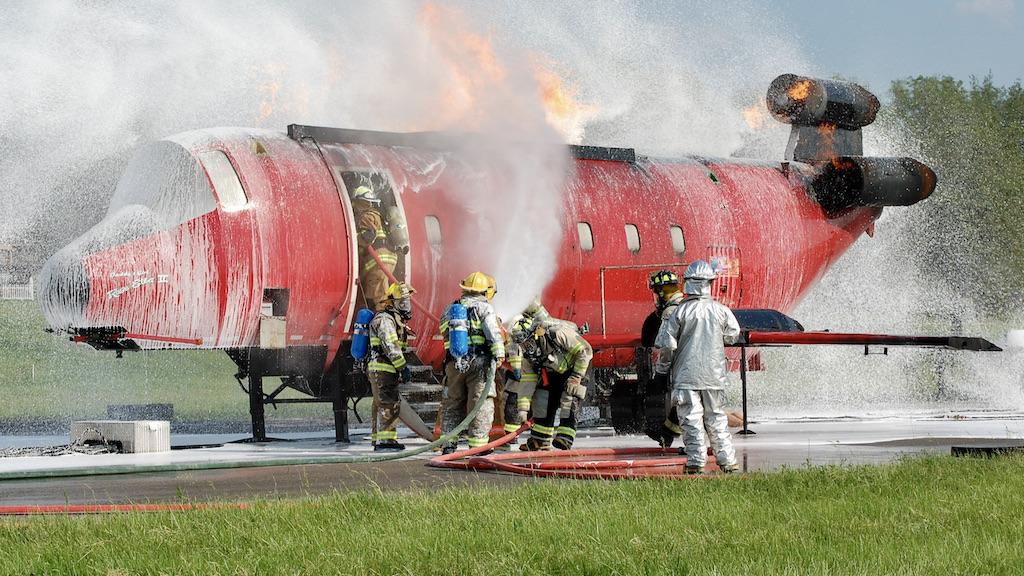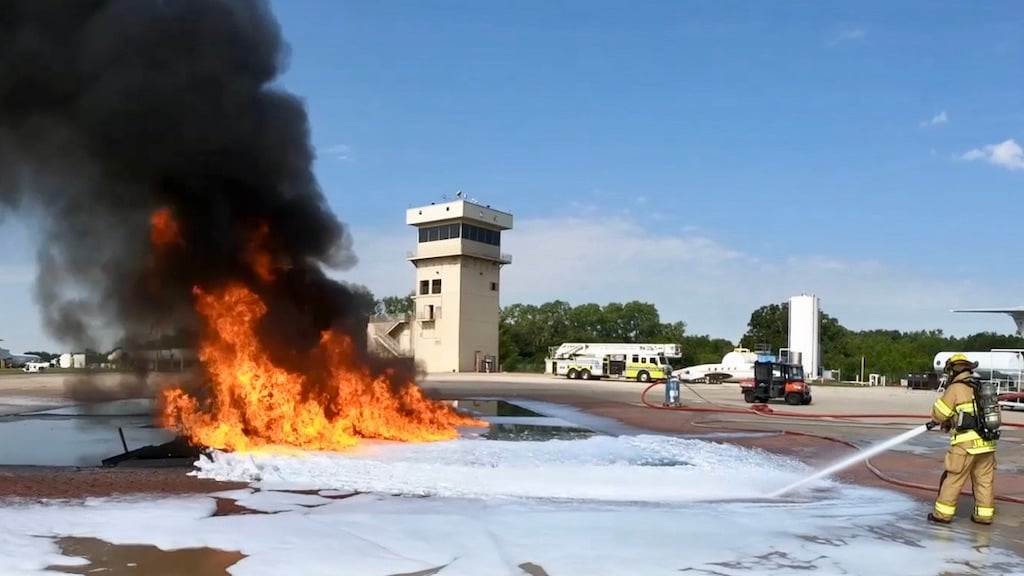
An Aircraft Rescue and Fire Fighting team dispenses foam on a fuselage during training.
Now that the FAA no longer requires airports to maintain foam fire-suppression systems containing PFAS compounds, foam users including FBOs and hangar owners face a legacy of contamination from the so-called “forever chemicals.”
Applied for decades in consumer products including nonstick cookware, food packaging, carpeting and waterproof clothing, Per- and Poly-fluoroalkyl Substances (PFAS) are also inherent in aqueous film-forming foams (AFFF) that are highly effective at fighting jet fuel and other Class B flammable liquid fires. When mixed with water and discharged, the foam forms an aqueous film that cuts off oxygen to a fire, extinguishes the blaze, and prevents it from relighting.
The synthetic chemicals have another characteristic; PFAS have a strong molecular structure based on a carbon-flourine bond that prevents them from breaking down in the environment, enabling them to infiltrate groundwater, soil, wildlife, food, and human bloodstreams. Studies of laboratory animals given large amounts of PFAS indicate the chemicals may have adverse health effects, but their toxicity for humans based on exposure to low environmental levels of PFAS is “uncertain,” says the U.S. Centers for Disease Control and Prevention.
Also uncertain are the potential liability consequences for airports and associated FBOs and hangars where AFFF has been used for decades in firefighting drills or has leaked or spilled accidentally from hangar fire suppression systems, potentially causing PFAS contamination.
Pending regulatory actions by the U.S. Environmental Protection Agency (EPA) could bring the legacy of PFAS-containing AFFF into clearer focus. In March, the EPA released a proposed National Primary Drinking Water regulation that would establish Maximum Contaminant Levels for six PFAS chemicals in drinking water, including Perfluorooctane sulfonate (PFOS) and Perfluorooctanoic acid (PFOA), two types of PFAS that are found in AFFF. The agency proposes a limit of no more than 4 parts per trillion for each chemical in drinking water, a standard that would be the lowest limit for any chemical the EPA regulates in water, according to the Sierra Club.
The EPA has said that it plans to finalize the regulation by the end of this year. The cost of addressing PFAS and other contaminants in drinking water will be initially covered by federal dollars, including $10 billion committed for that purpose in the 2021 Bipartisan Infrastructure Law.
Also pending is the publication by the EPA of a final rule designating certain PFAS chemicals, including PFOS and PFOA, as hazardous substances under the 1980 Comprehensive Environmental Response Compensation and Liability Act (Cercla), commonly known as the Superfund. Cercla establishes liability for current and former owners and operators of facilities where hazardous wastes were released or disposed of, as well as for manufacturers and handlers of such materials. Plans call for the EPA to publish the final rule in February 2024.
“Once it is deemed a Superfund site, all of the owners—anybody who owned the property or contributed to any release of contaminants on that site, whether they’re on the site or it migrated to the site, are potentially responsible parties,” says attorney Brian Gross, a partner with MG+M The Law Firm. “No defense; if you own [property] or you contributed, you owe money. If you are deemed to be a potentially responsible party, you’re on the hook.”
Future Firefighting Foams

The FAA has required that Part 139 commercial airports use AFFF firefighting foam, based on a specification developed by the U.S. Navy, since the 1980s. In 2018 reauthorization legislation, Congress directed the FAA to no longer require the use of fluorinated chemicals to meet its performance standards for aircraft fire-extinguishing agents—a mandate the agency says accelerated FAA and Defense Department (DOD) research into unfluorinated, PFAS-free alternative foams. In a policy directive dated June 20, 2019, the FAA advised Airport Certification Safety Inspectors to no longer require the discharge of AFFF during firefighting drills.
On Jan. 6, 2023, the Defense Department published a fluorine-free foam (F3) military specification (Mil-PRF-32725) to comply with requirements of the fiscal 2020 National Defense Authorization Act. Defense authorization legislation also directs the Pentagon, which has identified 700 sites of its own to assess for PFAS contamination, to start qualifying new foam products by October 2023 and to phase out its use of AFFF at military installations by October 2024. Once the Defense Department certifies that a manufacturer’s foam meets the new specification, it will be added to the Pentagon’s Qualified Product List (QPL).
(Perimeter Solutions, a St. Louis-based manufacturer of firefighting foam concentrates, announced Sept. 13 that its Solberg foam was the first product qualified to the F3 specification and added to the QPL.)
The FAA issued CertAlert 23-01 on Jan. 12, 2023, stating that it will accept the use of F3 foams qualified to Mil-PRF-32725 by Aircraft Rescue and Fire Fighting departments at Part 139 airports, but not require that they transition to the new foam.
A Regulatory Distinction

Responding to another congressional directive, the FAA in May released an 18-page “Aircraft Firefighting Foam Transition Plan.” In the plan, the agency says it will provide guidance to airport operators on mil-spec F3 issues falling within its regulatory purview; for issues outside of its authority, it will identify best practices when they become available.
State environmental regulations and fire-suppression systems at airport hangars are outside of its authority, the FAA says, underscoring a distinction between airports and hangar owners. “Although airport hangars are outside FAA’s regulatory jurisdiction, airports should consider hangar fire suppression systems as significant sources of PFAS-containing AFFF and include such systems, as appropriate, in transition planning and execution,” the agency says in a footnote.
To date, mainly state agencies have brought enforcement actions against Part 139 airports, compelling them to test for the presence of PFAS or to remediate contamination, Gross says.
Hangar owners install fixed foam fire-suppression systems as specified by the National Fire Protection Association (NFPA) 409 Standard on Aircraft Hangars, a standard applied by local fire marshals. The International Building Code and the International Fire Code—among “I-Codes” developed by the International Code Council and adopted by local jurisdictions—also reference the NFPA standard and take precedence.
NFPA 409 was revised in 2022 to exempt Group II hangars typical of FBOs and general aviation bases from requiring foam-water fire-suppression systems unless “hazardous operations” are performed within the hangar. (Such operations include fuel transfer, welding, torch cutting, torch soldering, doping, spray painting, oxygen service, composite repairs, fuel tank maintenance, wiring changes and electrical system testing.) The exemption was irrespective of whether aircraft are fueled or not. A Group II hangar as classified by NFPA 409 has a door height of 28 ft. or less and a hangar bay less than 40,000 ft2.
Current I-Codes still reference the 2016 edition of NFPA 409, however, which requires Group II hangars to have foam fire-suppression systems unless the facility meets certain conditions; for example, the hangar is only used for housing transient aircraft.
Industry anticipates NFPA 409 and the building and fire codes will be reconciled in the next edition of the I-Codes in 2027. But until then, enforcement of the requirement for foam fire suppression has been uneven, depending on the interpretation of the local fire marshal and allowance for the use of the 2022 edition of NFPA 409, says Megan Eisenstein, National Air Transportation Association (NATA) managing director of industry affairs and innovation.
“We are in this hard position where it’s not the federal government telling us we have to have these foams in hangars, it’s other local statutes and regulations such as NFPA 409,” Eisenstein says.
NATA advocates exempting from potential litigation all federally funded airports, hangar owners, aviation businesses and airport lease-holders that have been required by authorities having jurisdiction to maintain foam fire suppression systems containing PFAS, with a focus on its member FBOs and Part 135 operators that own or operate hangars on airport grounds.
In May, U.S. Sen. Cynthia Lummis (R-Wyo.) introduced the Airports PFAS Liability Protection Act (S. 1433) and related bills that would create Cercla liability protections for PFAS releases associated with certain industries and municipalities. Seven other Republican senators co-sponsored the suite of legislation.
Accidental Discharges

Another evident distinction between airports and hangars is that aircraft rescue and firefighting services at Part 139 airports have deployed foam mainly during recurrent training exercises, while foam releases in hangars are typically inadvertent.
A NATA-sponsored study of foam system discharges in aircraft hangars by the University of Maryland (UMD) Department of Fire Protection Engineering, dated November 2019, gathered data from seven insurance companies, two FBOs and media outlets. Of 174 reported incidents from 2004-19, 37 were foam discharges in response to a fire and 137 were accidental discharges. None of the 37 discharges in response to a fire involved a fuel spill.
“Requirements for foam fire-suppression systems in NFPA 409 were initially justified to provide protection from fires involving fuel spills,” the study authors stated. “However, the occurrence of a fuel spill in a hangar in the U.S. is rare and fires involving such spills even less common. While some fires do occur in aircraft hangars, they involve ordinary combustibles or occur in spaces adjacent to the hangar bay.”
A February 2021 UMD study analyzed hangar foam-system discharges experienced by commercial airlines and Defense Department facilities dating to the 1960s, but mainly from 2004-20. Of 217 reported incidents with known causes, 214 were accidental discharges with no fire present and three, all at military facilities, were discharges in response to a fire.
The prevalence of accidental foam discharges in hangars introduces another complexity to the liability equation if PFAS contamination is discovered.
“A lot of the utilization of (AFFF) is accidental,” Gross notes. “The question is, were there any safeguards in place to collect (the foam) so it didn’t run off? If not, hangar owners are potentially responsible for that. If it’s an accidental discharge, they’re certainly going to have a claim against the manufacturer of the system, assuming it was a malfunction of the system that created the discharge and not some human error. If it’s human error, if it’s somebody who is not employed by the hangar owner, perhaps they would have a claim against whoever discharged the fire protection system.”
Gross has served as counsel for several entities facing enforcement actions related to PFAS and other contaminants. “If you’re found liable, the first thing you do is look to spread the wealth, you look to see who else might be responsible,” he says.
But one potential downside for FBOs and hangar owners is that an airport facing an enforcement action may look to them to determine if any of the contamination originated from their facilities. “If you’re talking about a private hangar, at least those that are on Part 139 airports, they are potentially going to be one of several (facilities) that are responsible,” Gross said. “[At] smaller airports, they could be the only one responsible.”
Water sampling of private wells around Gustavus Airport, Alaska, in 2018 found PFAS concentrations above Alaska Department of Environmental Conservation (DEC) action levels in 19 wells. “Of these, one well serves the Alaska Airlines and Alaska Seaplanes terminals, six wells are used for airplane washing or other non-drinking-water uses, and 12 are private or business wells used for drinking water,” says the state’s Department of Transportation and Public Utilities. “One of these well results is due to city firefighting foam use.”
In November 2022, the Alaska DEC and state agencies in Illinois, Michigan, Minnesota, Nebraska and Wisconsin wrote to then-acting FAA Administrator Billy Nolen seeking a commitment from the agency to secure federal funding to help commercial airports investigate the extent of PFAS contamination. They also sought help to put in place controls to address risks associated with the chemicals.
In a following article, we describe a pilot project to stem PFAS migration at Martha's Vineyard Airport in Massachusetts.





